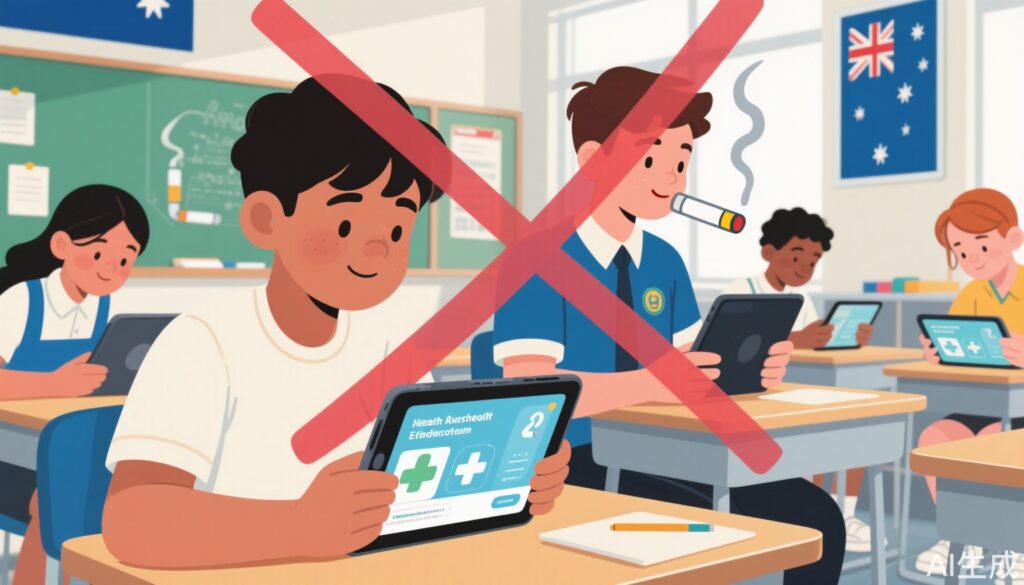Highlights
- The OurFutures Vaping eHealth intervention achieved a 65% reduction in the odds of e-cigarette use among adolescents at one year compared to usual health education.
- Cluster randomized controlled trial across 40 Australian secondary schools involving over 5,000 students.
- No adverse events reported, highlighting the safety and acceptability of the digital program.
- Findings demonstrate the scalability and effectiveness of web-based, school-centered prevention strategies in curbing adolescent vaping.
Clinical Background and Disease Burden
E-cigarette (vaping) use among adolescents has rapidly emerged as a significant public health concern, with prevalence rising in many high-income countries, including Australia. Adolescents are particularly vulnerable to nicotine dependence, cognitive impairment, and respiratory issues associated with vaping. There is a pressing need for scalable, evidence-based prevention strategies that can be implemented broadly in school settings to address this growing epidemic. Traditional health education programs have demonstrated limited efficacy, and the rapidly evolving landscape of vaping products necessitates innovative approaches that are both engaging and adaptable.
Research Methodology
The OurFutures Vaping trial was a two-arm, cluster randomized controlled study conducted between January and October 2023, across three Australian states: New South Wales, Western Australia, and Queensland. Eligible participants included Year 7 and 8 students (ages 12-14) from 40 secondary schools, with randomization stratified by state and school gender composition. Schools were randomized 1:1 to either the intervention (OurFutures Vaping: a four-lesson, web-based educational and skills training program) or an active control (usual health education curriculum).
All students attending participating schools, fluent in English, and with parental consent were included. The intervention was administered within the school environment, and both students and teachers were aware of group allocation. The primary endpoint was self-reported past 12-month e-cigarette use, assessed at 12 months post-intervention. Intention-to-treat analyses were performed using generalized mixed effects regression, appropriately accounting for clustering by school.
Of 49 schools initially recruited (7,653 students), 40 schools (5,157 eligible students: 46% girls, 51% boys; mean age 13.3 years) completed baseline assessments and were included in analyses. The trial was prospectively registered (ACTRN12623000022662), and funded by the Medical Research Future Fund and the Australian National Health and Medical Research Council.
Key Findings
The OurFutures Vaping intervention produced a statistically and clinically significant reduction in adolescent vaping. At 12-month follow-up, students in the intervention group had 65% lower odds of reporting past-year e-cigarette use compared to controls (odds ratio 0.35, 95% CI 0.18-0.66, p=0.0013). This effect was robust across the intention-to-treat population, and no adverse events were reported, supporting both the safety and acceptability of this digital educational approach.
The magnitude of risk reduction is notable, especially considering the relatively brief, four-session digital curriculum. These findings offer compelling evidence that high-quality, web-based programs can be deployed at scale to meaningfully impact adolescent health behaviors.
Mechanistic Insights and Biological Plausibility
The OurFutures Vaping intervention is grounded in cognitive-behavioral and social learning theories, aiming to build refusal skills, enhance awareness of vaping risks, and counteract social influences that promote e-cigarette use. By leveraging interactive, web-based content tailored for adolescents, the program likely enhanced engagement and knowledge retention. The observed behavioral impact aligns with established evidence that skill-building and normative education can reduce substance use initiation among youth.
Expert Commentary
These results resonate with calls from leading public health authorities for innovative, scalable interventions to address youth vaping. The trial’s rigorous methodology and statistically robust outcomes set a new standard for school-based prevention. As the World Health Organization and local policy makers highlight the urgency of addressing adolescent nicotine exposure, the OurFutures Vaping model offers a pragmatic, evidence-based template for future policy and implementation.
Controversies and Limitations
Despite its strengths, several limitations merit discussion. The intervention and outcome assessments were not blinded, introducing potential for reporting bias. The reliance on self-reported vaping behaviors, while standard in large-scale adolescent research, may underestimate true prevalence. Attrition of nine schools before baseline (more in the intervention arm) may introduce selection bias, though baseline characteristics were well balanced. The generalizability of findings to non-English-speaking populations, or settings outside Australia, is uncertain. Finally, the study did not assess long-term (>12 months) sustainability of effects or cost-effectiveness, both crucial for informing large-scale policy adoption.
Conclusion
The OurFutures Vaping cluster RCT provides robust evidence that a brief, web-based school intervention can substantially reduce e-cigarette use among adolescents over 12 months. These results support the integration of digital health education into school curricula as a scalable, safe, and effective prevention strategy against youth vaping. Future research should explore adaptation to diverse cultural settings, long-term maintenance of effects, and cost-effectiveness analyses to inform broad policy implementation.
References
Gardner LA, Newton NC, Rowe AL, O’Dean S, Teesson M, Hides L, McBride N, Sunderland M, Freeman B, Egan L, Hawkins A, Ellem R, Catakovic A, Caradmone E, Alcorn C, Blackburn K, East J, Thornton L, Stapinski L, Birrell L, Lee YY, Mihalopoulos C, Leung J, McRobbie H, Lee N, Allsop S, Champion KE, Stockings E. The OurFutures Vaping eHealth intervention to prevent e-cigarette use among adolescent students in Australia: a cluster randomised controlled trial. Lancet Public Health. 2025 Aug;10(8):e682-e692. doi: 10.1016/S2468-2667(25)00145-8. PMID: 40738553.
World Health Organization. E-cigarettes and similar devices. 2024. https://www.who.int/news-room/fact-sheets/detail/e-cigarettes-and-similar-devices
Australian Institute of Health and Welfare. Smoking and vaping. 2023. https://www.aihw.gov.au/reports/illicit-use-of-drugs/smoking-and-vaping



